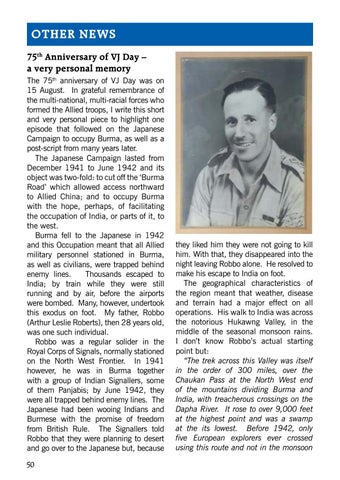OTHER NEWS 75th Anniversary of VJ Day – a very personal memory The 75th anniversary of VJ Day was on 15 August. In grateful remembrance of the multi-national, multi-racial forces who formed the Allied troops, I write this short and very personal piece to highlight one episode that followed on the Japanese Campaign to occupy Burma, as well as a post-script from many years later. The Japanese Campaign lasted from December 1941 to June 1942 and its object was two-fold: to cut off the ‘Burma Road’ which allowed access northward to Allied China; and to occupy Burma with the hope, perhaps, of facilitating the occupation of India, or parts of it, to the west. Burma fell to the Japanese in 1942 and this Occupation meant that all Allied military personnel stationed in Burma, as well as civilians, were trapped behind enemy lines. Thousands escaped to India; by train while they were still running and by air, before the airports were bombed. Many, however, undertook this exodus on foot. My father, Robbo (Arthur Leslie Roberts), then 28 years old, was one such individual. Robbo was a regular solider in the Royal Corps of Signals, normally stationed on the North West Frontier. In 1941 however, he was in Burma together with a group of Indian Signallers, some of them Panjabis; by June 1942, they were all trapped behind enemy lines. The Japanese had been wooing Indians and Burmese with the promise of freedom from British Rule. The Signallers told Robbo that they were planning to desert and go over to the Japanese but, because 50
they liked him they were not going to kill him. With that, they disappeared into the night leaving Robbo alone. He resolved to make his escape to India on foot. The geographical characteristics of the region meant that weather, disease and terrain had a major effect on all operations. His walk to India was across the notorious Hukawng Valley, in the middle of the seasonal monsoon rains. I don’t know Robbo’s actual starting point but: “The trek across this Valley was itself in the order of 300 miles, over the Chaukan Pass at the North West end of the mountains dividing Burma and India, with treacherous crossings on the Dapha River. It rose to over 9,000 feet at the highest point and was a swamp at the its lowest. Before 1942, only five European explorers ever crossed using this route and not in the monsoon












